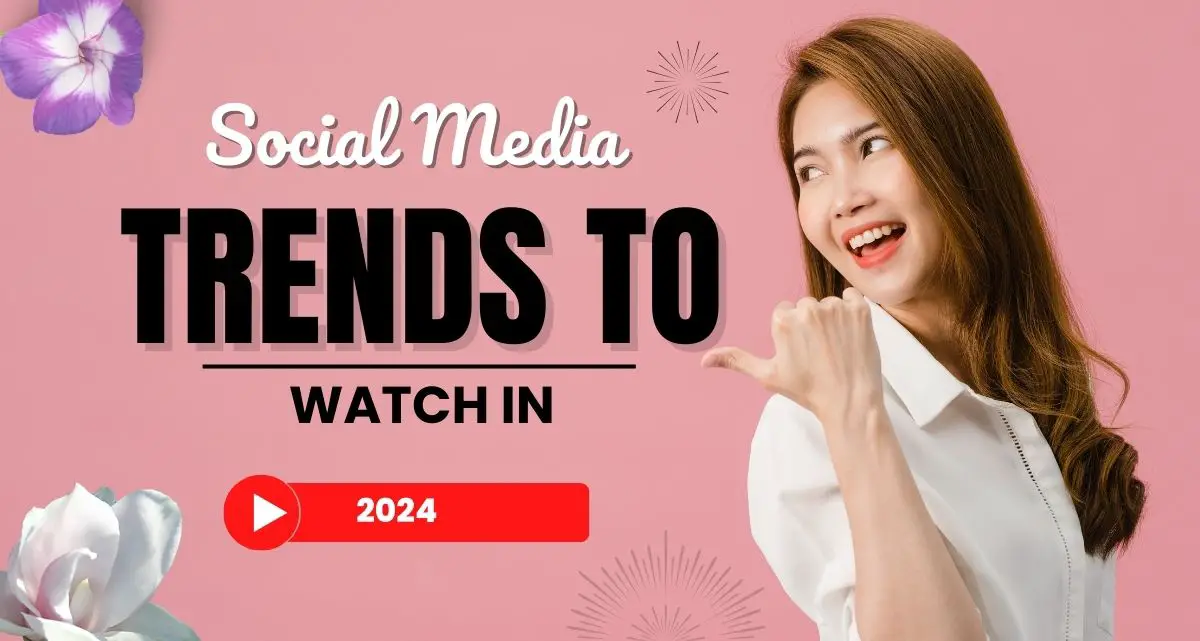Social media evolves constantly, and staying updated with the latest trends can keep your brand ahead of the curve. As 2024 rolls in, these emerging trends are set to redefine how businesses connect with audiences. Here are the top social media trends to watch this year.
- Social Media Trends 2024: What to Expect This Year
- 1. AI-Powered Content Creation
- 2. Short-Form Video Dominance
- 3. The Rise of Social Commerce
- 4. User-Generated Content (UGC) and Community Building
- 5. Augmented Reality (AR) and Immersive Experiences
- 6. Authentic and Transparent Content
- 7. Influencer Partnerships with Micro and Nano Influencers
- 8. Employee Advocacy as Brand Ambassadors
- 9. Data-Driven Content and Personalisation
- 10. Sustainability and Eco-Conscious Content
- The Bottom Line
Social Media Trends 2024: What to Expect This Year
Stay ahead of the curve with the latest social media trends for 2024. Discover emerging platforms, innovative content formats, and effective strategies to engage your audience.
1. AI-Powered Content Creation
AI-driven tools are revolutionising content creation, enabling brands to produce engaging visuals, videos, and copy at scale. From automated video editing to AI-generated blog posts, these tools empower marketers to streamline workflows and improve creative output.
Why It Matters:
AI content generation allows brands to maintain a consistent content schedule without overextending resources. Additionally, platforms like ChatGPT and Midjourney help generate unique, on-brand content that resonates with specific target audiences.
Pro Tip:
Use AI tools for brainstorming, visual design, or writing captions, but add a human touch for authenticity.
2. Short-Form Video Dominance
Short-form video content remains king across platforms like TikTok, Instagram Reels, and YouTube Shorts. These bite-sized, engaging videos grab attention quickly, making them highly effective for brand storytelling and capturing audiences with short attention spans.
Why It Matters:
Short-form videos generate high engagement rates and are easy to consume. This format allows brands to deliver quick, memorable messages that resonate across age groups and demographics.
Pro Tip:
Leverage trends by creating entertaining, informative, or humorous content that can be repurposed across multiple platforms. Experiment with AR filters and effects to make your videos stand out.
3. The Rise of Social Commerce
Social media platforms continue to integrate shopping features, allowing users to discover, browse, and purchase products without leaving the app. With live shopping events and shoppable posts, social commerce will likely see exponential growth in 2024, transforming social platforms into e-commerce hubs.
Why It Matters:
Social commerce provides a seamless shopping experience, making it easier for brands to convert followers into customers. Instagram, Facebook, and TikTok are leading the charge, enabling brands to reach consumers in real-time with shoppable content.
Pro Tip:
Optimise your social commerce strategy with visually appealing product showcases, user-generated content, and interactive features like live demos and Q&A sessions during live shopping events.
4. User-Generated Content (UGC) and Community Building
In 2024, brands will focus on building tight-knit communities by encouraging and sharing user-generated content. UGC adds authenticity and boosts brand loyalty, as customers feel more connected to a brand when their content is shared.
Why It Matters:
People trust content from other users more than traditional brand messaging. By promoting UGC, brands can foster a sense of community, enhance credibility, and drive organic reach.
Pro Tip:
Run UGC campaigns by creating branded hashtags or hosting contests. Highlight customer testimonials and stories to build trust and encourage others to share their experiences with your brand.
5. Augmented Reality (AR) and Immersive Experiences
AR tools are becoming more accessible and advanced, allowing brands to create immersive experiences that engage audiences on a new level. From virtual try-ons to interactive filters, AR technology can enhance the social media experience by adding an element of interactivity.
Why It Matters:
AR captivates audiences and drives engagement by offering fun, personalised experiences. Brands in fashion, beauty, and retail can especially benefit by allowing users to “try before they buy” through virtual try-ons.
Pro Tip:
Experiment with AR filters and interactive experiences tailored to your brand. For example, a beauty brand might create an AR filter allowing users to “try on” different shades of lipstick.
6. Authentic and Transparent Content
Today’s audiences value transparency and honesty from brands. As a result, polished, overly edited posts are taking a back seat to real, unfiltered content that shows the human side of brands. This shift includes more behind-the-scenes content, honest reviews, and a greater focus on corporate social responsibility (CSR).
Why It Matters:
Authenticity fosters trust and builds stronger connections with audiences. Transparent content aligns with the growing consumer demand for ethical and socially conscious brands.
Pro Tip:
Share stories about your brand’s values, initiatives, and the people behind your products. Be transparent about setbacks and wins, giving audiences an unfiltered view of your brand journey.
7. Influencer Partnerships with Micro and Nano Influencers
While big-name influencers still hold sway, micro (10,000–50,000 followers) and nano (1,000–10,000 followers) influencers have higher engagement rates and are more cost-effective. These influencers often have niche audiences with strong loyalty, making them valuable partners for brands looking for authentic engagement.
Why It Matters:
Micro and nanoinfluencers allow brands to reach targeted audiences with a more personal touch. Their recommendations are perceived as more genuine, leading to higher trust and better engagement.
Pro Tip:
When choosing influencers, focus on audience relevance over follower count. Collaborate on authentic content that highlights your product's real value within the influencer’s niche.
8. Employee Advocacy as Brand Ambassadors
Brands are increasingly turning to their employees to act as ambassadors. Employee advocacy humanises the brand and enhances its credibility, as audiences are more likely to trust people over faceless corporations. This trend also helps with recruitment and showcases a positive workplace culture.
Why It Matters:
Employees offer an authentic perspective on the brand, making it more relatable. Their involvement also boosts reach by extending the brand message to the employees’ own social circles.
Pro Tip:
Encourage employees to share behind-the-scenes content, insights, and positive experiences. Offer guidance or resources on brand messaging to ensure consistency without restricting creativity.
9. Data-Driven Content and Personalisation
Brands that leverage data to understand their audience's preferences can create hyper-targeted content. By using analytics tools, brands can track user behaviour, segment audiences, and personalise content based on audience interests, making interactions more meaningful and effective.
Why It Matters:
Personalised content resonates with audiences by addressing their specific needs and interests, which can lead to higher engagement and better conversion rates.
Pro Tip:
Use audience insights to inform your content strategy. Segment audiences based on factors like interests, location, and engagement history, and tailor your content to each segment.
10. Sustainability and Eco-Conscious Content
Consumers are increasingly prioritising sustainability, and they expect brands to do the same. In 2024, brands will need to show tangible efforts towards sustainability and share eco-conscious practices. Transparent and authentic communication around sustainability efforts will resonate well with socially aware audiences.
Why It Matters:
Brands that openly commit to sustainability build trust and appeal to environmentally conscious consumers. Highlighting green initiatives can differentiate your brand in a competitive landscape.
Pro Tip:
Share stories about how your brand is reducing waste, using sustainable materials, or supporting environmental initiatives. Highlight customer feedback on eco-friendly products to boost credibility and drive engagement.
The Bottom Line
The social media landscape in 2024 will be marked by an emphasis on authenticity, personalisation, and interactive experiences. Brands that can adapt to these trends—by leveraging AI, prioritising user-generated content, and embracing transparency—will be well-positioned to build meaningful connections with their audiences. By keeping these trends in mind, your brand can stay ahead and make the most of the evolving social media space.







